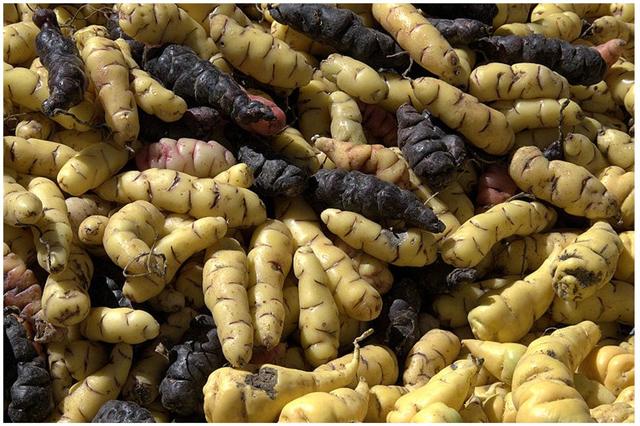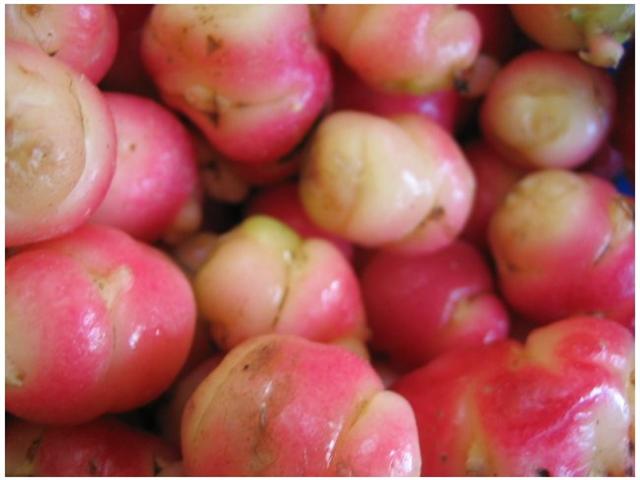4. Let us now leave my speculations and return to
Kuukuu the planter (probably an alias for the planet Mars). By
Ira he was entrusted the task of digging in the ground, and
maybe we should repeat the circumstances:
| Ira sat down
with all the other (companions) |
he noho a ira
anake. |
| and spoke to Makoi: |
he ki a Ira.ka ki
era kia Makoi. |
| 'You shall mark the
land for me and make it known (by its name)!' |
maau e tuki e
haite te kainga. |
| After that, Ira
spoke these words: |
he ki hokoou a
Ira.ka ki era. |
| 'This is the digging
stick (? ko koko), Kuukuu. |
kokoko e Nguukuu
e. |
| You shall work the
land for me and plant the yam roots!' |
maau e keukeu e
oka te uhi. |
Then they walked together upwards, as when Sun
climbs up from the sea at Poike, and we can recognize a parallel between Hanga Te Pau and
Hanga Takaure:
| Makoi
named the place Hanga Te Pau, 'the
landing site of Ira'. So that they
would remember (? he aringa,
literally, 'as face'), the open side of
Hanga Te Pau was given this name. |
he nape
mai a Makoi.i te ingoa.ko hanga te pau ko te
tomonga o Ira.he aringa.ko mua a hanga te
pau.i nape ai te ingoa. |
| Ira
got up. They all climbed to the top of the
hill. |
he ea.a
Ira.he iri he oho ki runga anake. |
| They climbed
up on the tenth day of the month of June 'Maro'. |
i te
angahuru o te ra o te maro i iri ai. |
| |
Birth of Moon (west) |
Birth of Sun (east) |
|
Old Land |
Te Pu Mahore |
Te Poko Uri |
Tama (*) |
One Tea (†) |
|
Sea |
|
New land |
Te Manavai |
Te
Kioe Uri |
Hanga Takaure |
Poike |
But the time was
wrong, and they had to go back to Te Manavai to
get it right. They had avoided to land their canoe
at the dangerously steep and high cliffs of the
southwestern corner of the island and they therefore had to go
back in timespace:
| They
reached the side crater (te
manavai) and looked around
carefully. |
he
tuku ki te manavai hee rarama. |
| Makoi
said, 'This is the Manavai of
Hau Maka.' |
he ki
a Makoi.ko te manavai a hau maka |
| They
climbed farther and reached the top. |
he iri
he oho he tuu ki runga |
| They saw
the dark abyss and the large hole (of
the crater Rano Kau). |
he ui
i te poko uri |
| They all
said, 'Here it is, young men, the dark
abyss of Hau Maka.' |
he
tikea te pakonga he ki anake i ana nei e
kau a repa e a te poko uri a hau maka. |
| They made
camp and constructed a house. |
he
noho o(i)ra he hakatuu i te hare. |
| Kuukuu
got up, worked the ground, and heaped up
the earth for the yam roots. |
he ea
a kuukuu he keukeu he puke i te uhi.
[end of page 18] |
At the proper entrance to the land Kuukuu heaped
up earth over the yam roots. It was winter solstice (and the
end of page 18 of the manuscript). The connection between
Sun and yam (uhi) was known to Metoro, which we can
see from the way he used the technical term e uhi tapamea
in the daylight calendar of Tahua:
 |
 |
 |
 |
|
Aa1-20 |
Aa1-21 |
Aa1-22 |
Aa1-23 |
| e
hetuu mau i te rima kua noho te marama |
e uhi tapamea |
e
hetu mata |
e
hokohuki |
 |
 |
 |
 |
|
Aa1-24 |
Aa1-25 |
Aa1-26 |
Aa1-27 |
| ko
te nuahine - i mamau i te ahi |
e uhi tapamea |
ko
te ahi - hakaturou |
ki
te henua |
 |
 |
 |
 |
|
Aa1-28 |
Aa1-29 |
Aa1-30 |
Aa1-31 |
| ka
puhi hoki ki te ahi |
ma
te hokohuki |
ki
te ahi |
e uhi tapamea |
Tapa-mea means 'red cloth', which we
easily will recognize as the opposite of the 'black cloth'
of night. Metoro did not say e uhi tapamea everywhere
when he saw a glyph of this type, which I have named tapa
mea:
|
 |
|
tapa mea |
Presumably Metoro regarded the daytime
sky roof as a complex structure similar to that of the
hare paega nighttime sky roof, because that would
explain why he was very systematic in using the correct
words:
 |
 |
 |
 |
 |
|
Aa1-19 |
Aa1-21 |
Aa1-25 |
Aa1-31 |
Aa1-36 |
| i
uhi
tapamea |
e
uhi
tapamea |
e
uhi
tapamea |
e
uhi tapamea |
e
uhi tapamea |
 |
 |
 |
 |
 |
|
Aa1-17 |
Aa1-23 |
Aa1-27 |
Aa1-29 |
Aa1-34 |
| ka
tapamea |
e
hokohuki |
ki te
henua |
ma te
hokohuki |
te
tapamea |
Probably both Metoro and the
creators of Manuscript E had not the ordinary yam in
mind but the kind originating in the Andes and
known as New Zealand Yam or Oca (Oka):
|
Wikipedia:
The Dioscorea
vegetables known elsewhere as yams are
generally very uncommon in these countries
[Bolivia, Colombia, Polynesia]. Yams are
commonly confused with Sweet potatoes,
although they are not closely related. In
New Zealand Sweet potatoes are commonly
referred to by their Māori name of kūmara.
Oxalis tuberosa is an
annual plant that overwinters as underground
stem tubers. These tubers are known as
oca , oka, or New Zealand Yam.
The plant was brought into cultivation in
the central and southern Andes for its
tubers, which are used as a root vegetable.
The plant is not known in the wild, but
populations of wild Oxalis species
that bear smaller tubers are known from four
areas of the central Andean region.
Introduced to Europe in 1830 as a competitor
to the potato and to New Zealand as early as
1860, it has become popular in that country
under the name New Zealand yam and is
now a common table vegetable.
Oca
is one of the important staple crops of the
Andean highlands, second only to the potato
due to its easy propagation, and tolerance
for poor soil, high altitude and harsh
climates.Outside of the Andean region
Oxalis tuberosa is cultivated
commercially in Mexico and New Zealand.
Compared to potatoes, which are now
cultivated in 130 countries around the
world, these tubers are essentially still
unknown outside of the Andean region.
Oca is usually
propagated vegetatively by planting of whole
tubers .... Oca need a long growing
season, and are day length dependent,
forming tubers when the day length shortens
in autumn ... In tropical areas where the
days are unchanging in length, oca
will not set a crop successfully.
|
It is hardly a coincidence that this
type of yam was named oka, i.e. the same name
as the quartet of boughs used for keeping the roof
up in a hare paega. Oka cannot
grow in the tropical belt because the plant is day
length dependent. The plant knows the time of the
year by somehow measuring the length of the day.
Their tubers form in autumn when the days are
gradually becoming shorter. Metoro
evidently used 5 tapa mea glyphs, each with 3
+ 3 front marks, in order to formulate a message
containing number 30 together with uhi tapamea
in order for Bishop Jaussen to understand the
meaning of the 'daylight calendar' in Tahua.
We will not be able to understand the words of
Metoro without taking into consideration also the
signs of the surronding glyphs. We need the whole
picture. Measuring the year it would
be natural to first mention the yam roots, their
tubers had to be planted early in the year (by using
digging sticks, oka):
|
1st half |
1st half |
yam roots |
Te
Uhi |
|
2nd half |
sweet potatoes |
Te
Kumara |
|
2nd half |
1st half |
'hard fruit' |
Te
Makoi |
|
2nd half |
bananas |
Te
Maika |
The proper
time of the year for this activity was not
winter solstice but when the days were growing
longer:
|
1 He Anakena |
2 Hora iti |
3 Hora nui |
|
Same as the previous month. |
Planting of plants growing above
the ground (i.e., bananas,
sugarcane, and all types of trees).
Good
time to fish for eel along the
shore. |
Planting of plants growing below
the ground (i.e., sweet potatoes,
yams, and taro).
A fine
spring month. |
|
4 Tagaroa uri |
5 Ko Ruti |
6 Ko Koró |
|
Cleaning up of the fields. Fishing
is no longer taboo. Festival of
thanksgiving (hakakio) and
presents of fowl. |
Cleaning of the banana plantations,
but only in the morning since the
sun becomes too hot later in the
day. Problems with drought. Good
month for fishing and the
construction of houses (because of
the long days). |
Because of the increasing heat, work
ceases in the fields. Time for
fishing, recreation, and
festivities. The new houses are
occupied (reason for the
festivities). Like the previous
month, a good time for surfing (ngaru)
on the beach of Hangaroa O Tai. |
|
7 Tua haro |
8 Tehetu'upú |
9 Tarahao |
|
Fishing. Because of the strong sun
very little planting is done. |
Like the previous month. Some sweet
potatoes are planted where there are
a lot of stones (pu). |
Sweet potatoes are planted in the
morning; fishing is done in the
afternoon. |
|
10 Vaitu nui
|
11 Vaitu potu |
12 He Maro |
|
Planting of
sweet potatoes. |
Beginning of the
cold season. No
more planting.
Fishing is
taboo, except
for some fishing
along the beach.
Harvesting of
paper mulberry
trees (mahute).
Making of tapa
capes (nua). |
Because of the
cold weather,
nothing grows (tupu
meme), and
there is hardly
any work done in
the fields. Hens
grow an
abundance of
feathers, which
are used for the
festivities. The
time of the
great
festivities
begins, also for
the
father-in-law (te
ngongoro mo te
hungavai).
There is much
singing (riu). |
|








